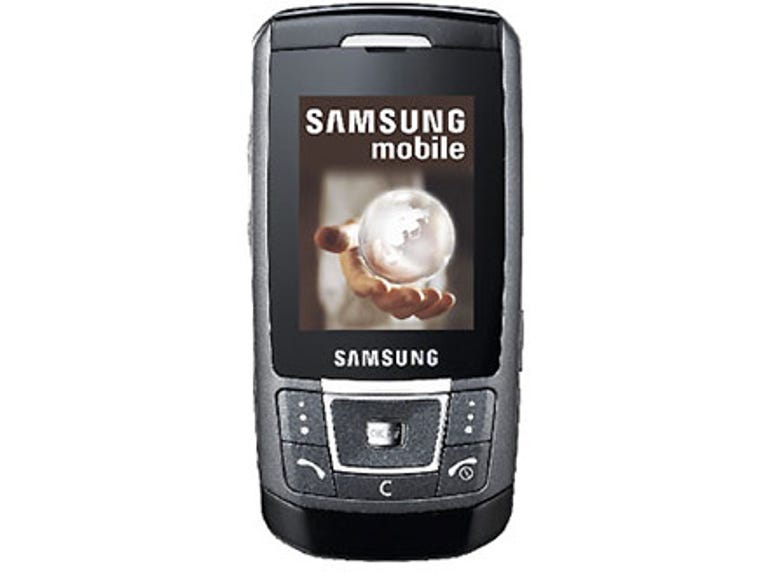 Why You Can Trust CNET
Why You Can Trust CNET Samsung D900 (Ultra Edition 12.9) review: Samsung D900 (Ultra Edition 12.9)
Samsung's D900 proves that it's entirely possible to take an existing phone design and put it on a serious slimming diet. Read our Australian review.
Design
Given that so many mobiles now offer pretty much exactly the same grab-bag of features -- music playback, Bluetooth connectivity, decent-but-not-spectacular cameras and so on -- the more pressing differentiator between one model or another has to come from the design of the phone itself. After all, it's not as though you can show your mates the nifty Bluetooth chip within your phone, now can you? That kind of thinking was clearly in the minds of the D900's designers, who have pushed what they claim is the world's slimmest slider phone -- it measures in at 103mm by 51mm by 12.9mm and weighs 85 grams -- onto the local market. For a phone with such a strong design focus, it's interesting to note that the D900 fits in Samsung's business range. Naturally, there's nothing that says that a business phone can't be sexy -- and indeed, if you can convince the boss to stump up for a phone that looks this good, then you can give yourself a hearty pat on the back.
The Good
The Bad
The Bottom Line
The D900 superficially resembles a number of other Samsung phones in terms of overall design -- it's rather like the supermodel-thin version of the 3G Z400, Z500 or Z600, in fact. It's a slider phone with a four-way selector, call and option buttons built into the top part of the slider, while standard dialling keys sit beneath the sliding portion of the phone. The 240 x 320 pixel 2.12-inch display is clear and very bright, although like most slider phones it blanks out when not in use to preserve battery life.
Features
The D900 is a Quad-Band (850/900/1800/1900) GSM phone, so you should be able to use it just about anywhere that a GSM signal propagates on the planet. The integrated mobile camera is an autofocus 3-megapixel model with 4x digital zoom. It's true of all digital zooms, but even more so with mobile cameras -- if you want a bigger shot, you're much better off moving closer to your target in the first place. On the connectivity front, the D900 supports Bluetooth, USB 1.1 connections and PictBridge. Music is supported via MP3, AAC, AAC+, and e-AAC+ audio. There's also the usual raft of SMS/MMS and Java support that you'd expect out of a phone in this price bracket.
Performance
Samsung rates the D900 as having a talk time of three hours and a standby time of 250 hours. In our tests we tended to need to recharge every three to four days on a moderate usage pattern, which is about average for a phone these days; neither good nor bad.
The D900's 3-megapixel camera also makes it capable of recording video that's compliant with the H.263 and MPEG4 standards at a top resolution of 352x288 pixels and at 30 frames per second. In our tests we were unable to unseat Mr Spielberg from his roost atop Hollywood -- but were pleasantly surprised with our results given the generally shoddy quality of most mobile camera video.
Our main concerns with the D900 came about pretty much exclusively based on the physical design, which has seemingly necessitated a few compromises -- in terms of the side ports -- and a few parts that feel a little cheaper than they really should. Firstly, and on a minor scale, the directional pad underneath the screen is a touch large compared to the OK button. We found that we would intermittently hit left or right when trying to accept a selection; depending on the menu context this isn't always a tragedy, but it is annoying. Likewise, the sliding motion of the D900 is a touch on the rough side, with a very audible click into place; compared to something like the very smooth LG Chocolate KG800 this feels a little unsophisticated.
Of more concern to us were the side slots. The nature of a super-slim phone is naturally one where it's tricky to fit anything onto the side, but Samsung have chosen to stick the power/headphone socket on the right hand side and the microSD slot on the right hand side underneath some very tightly held socket covers. If you're someone not possessed of long fingernails (or someone worried about breaking good fingernails) you may find this troublesome -- we certainly did. Once opened, too, they're a problem, and like many loose-hanging socket covers we envisage breakage in the future. Because the power and headphones use a custom connector, you're also tied into using Samsung-provided headphones with the D900.
There's definitely a certain cachet in having a thinner phone than anyone else, and while it does introduce some design challenges, we were overall very pleased with the D900 in terms of its features and general phone performance.


